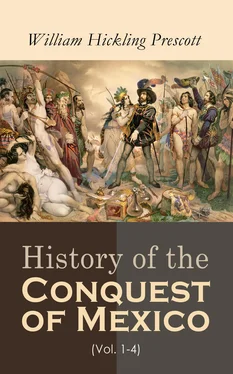They imagined three separate states of existence in the future life. The wicked, comprehending the greater part of mankind, were to expiate their sins in a place of everlasting darkness. Another class, with no other merit than that of having died of certain diseases, capriciously selected, were to enjoy a negative existence of indolent contentment. The highest place was reserved, as in most warlike nations, for the heroes who fell in battle, or in sacrifice. They passed at once into the presence of the Sun, whom they accompanied with songs and choral dances in his bright progress through the heavens; and, after some years, their spirits went to animate the clouds and singing-birds of beautiful plumage, and to revel amidst the rich blossoms and odors of the gardens of paradise. [105]Such was the heaven of the Aztecs; more refined in its character than that of the more polished pagan, whose elysium reflected only the martial sports or sensual gratifications of this life. [106]In the destiny they assigned to the wicked, we discern similar traces of refinement; since the absence of all physical torture forms a striking contrast to the schemes of suffering so ingeniously devised by the fancies of the most enlightened nations. [107]In all this, so contrary to the natural suggestions of the ferocious Aztec, we see the evidences of a higher civilization, [108]inherited from their predecessors in the land.
Our limits will allow only a brief allusion to one or two of their most interesting ceremonies. On the death of a person, his corpse was dressed in the peculiar habiliments of his tutelar deity. It was strewed with pieces of paper, which operated as charms against the dangers of the dark road he was to travel. A throng of slaves, if he were rich, was sacrificed at his obsequies. His body was burned, and the ashes, collected in a vase, were preserved in one of the apartments of his house. Here we have successively the usages of the Roman Catholic, the Mussulman, the Tartar, and the ancient Greek and Roman; curious coincidences, which may show how cautious we should be in adopting conclusions founded on analogy. [109]
A more extraordinary coincidence may be traced with Christian rites, in the ceremony of naming their children. The lips and bosom of the infant were sprinkled with water, and “the Lord was implored to permit the holy drops to wash away the sin that was given to it before the foundation of the world; so that the child might be born anew.” [110]We are reminded of Christian morals, in more than one of their prayers, in which they used regular forms. “Wilt thou blot us out, O Lord, forever? Is this punishment intended, not for our reformation, but for our destruction?” Again, “Impart to us, out of thy great mercy, thy gifts, which we are not worthy to receive through our own merits.” “Keep peace with all,” says another petition; “bear injuries with humility; God, who sees, will avenge you.” But the most striking parallel with Scripture is in the remarkable declaration that “he who looks too curiously on a woman commits adultery with his eyes.” [111]These pure and elevated maxims, it is true, are mixed up with others of a puerile, and even brutal, character, arguing that confusion of the moral perceptions which is natural in the twilight of civilization. One would not expect, however, to meet, in such a state of society, with doctrines as sublime as any inculcated by the enlightened codes of ancient philosophy. [112]
But although the Aztec mythology gathered nothing from the beautiful inventions of the poet or from the refinements of philosophy, it was much indebted, as I have noticed, to the priests, who endeavored to dazzle the imagination of the people by the most formal and pompous ceremonial. The influence of the priesthood must be greatest in an imperfect state of civilization, where it engrosses all the scanty science of the time in its own body. This is particularly the case when the science is of that spurious kind which is less occupied with the real phenomena of nature than with the fanciful chimeras of human superstition. Such are the sciences of astrology and divination, in which the Aztec priests were well initiated; and, while they seemed to hold the keys of the future in their own hands, they impressed the ignorant people with sentiments of superstitious awe, beyond that which has probably existed in any other country,—even in ancient Egypt.
The sacerdotal order was very numerous; as may be inferred from the statement that five thousand priests were, in some way or other, attached to the principal temple in the capital. The various ranks and functions of this multitudinous body were discriminated with great exactness. Those best instructed in music took the management of the choirs. Others arranged the festivals conformably to the calendar. Some superintended the education of youth, and others had charge of the hieroglyphical paintings and oral traditions; while the dismal rites of sacrifice were reserved for the chief dignitaries of the order. At the head of the whole establishment were two high-priests, elected from the order, as it would seem, by the king and principal nobles, without reference to birth, but solely for their qualifications, as shown by their previous conduct in a subordinate station. They were equal in dignity, and inferior only to the sovereign, who rarely acted without their advice in weighty matters of public concern. [113]
The priests were each devoted to the service of some particular deity, and had quarters provided within the spacious precincts of their temple; at least, while engaged in immediate attendance there,—for they were allowed to marry, and have families of their own. In this monastic residence they lived in all the stern severity of conventual discipline. Thrice during the day, and once at night, they were called to prayers. They were frequent in their ablutions and vigils, and mortified the flesh by fasting and cruel penance,—drawing blood from their bodies by flagellation, or by piercing them with the thorns of the aloe; in short, by practising all those austerities to which fanaticism (to borrow the strong language of the poet) has resorted, in every age of the world,
“In hopes to merit heaven by making earth a hell.” [114]
The great cities were divided into districts, placed under the charge of a sort of parochial clergy, who regulated every act of religion within their precincts. It is remarkable that they administered the rites of confession and absolution. The secrets of the confessional were held inviolable, and penances were imposed of much the same kind as those enjoined in the Roman Catholic Church. There were two remarkable peculiarities in the Aztec ceremony. The first was, that, as the repetition of an offence once atoned for was deemed inexpiable, confession was made but once in a man’s life, and was usually deferred to a late period of it, when the penitent unburdened his conscience and settled at once the long arrears of iniquity. [115]Another peculiarity was, that priestly absolution was received in place of the legal punishment of offences, and authorized an acquittal in case of arrest. Long after the Conquest, the simple natives, when they came under the arm of the law, sought to escape by producing the certificate of their confession. [116]
One of the most important duties of the priesthood was that of education, to which certain buildings were appropriated within the enclosure of the principal temple. Here the youth of both sexes, of the higher and middling orders, were placed at a very tender age. The girls were intrusted to the care of priestesses; for women were allowed to exercise sacerdotal functions, except those of sacrifice. [117]In these institutions the boys were drilled in the routine of monastic discipline; they decorated the shrines of the gods with flowers, fed the sacred fires, and took part in the religious chants and festivals. Those in the higher school—the Calmecac , as it was called—were initiated in their traditionary lore, the mysteries of hieroglyphics, the principles of government, and such branches of astronomical and natural science as were within the compass of the priesthood. The girls learned various feminine employments, especially to weave and embroider rich coverings for the altars of the gods. Great attention was paid to the moral discipline of both sexes. The most perfect decorum prevailed; and offences were punished with extreme rigor, in some instances with death itself. Terror, not love, was the spring of education with the Aztecs. [118]
Читать дальше












